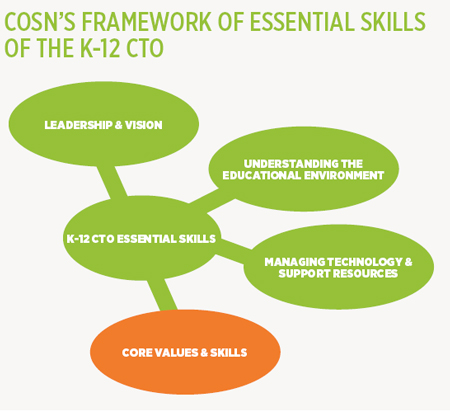The Best Defense

Everyone knows CIOs are vital to school success—right?
At the SchoolCIO Technology Summit this June, we were devastated to hear that many superintendents still see the CIO job as tech support rather than an integral part of the district. Even worse, some of our attendees told us they’re in danger of losing their jobs.
Take Cary Petersen, for example. This July, Petersen went from spending eight years as executive director of IT for Jefferson County (KY) Public Schools to becoming the manager of advanced systems. In his former role, Petersen was in charge of all the tech support and MIS functions as well as instructional technology. He had five direct reports and managed a team of 120 people. Today, he works on the district’s student information system, manages state reporting, and controls some of the former technology funds. “I’m not sure who will create the next tech plan,” he says. “I used to chair a tech committee that did all of the planning and execution of the plan, but once the auditors dissolved my position, the committee was dissolved too.”

Steven M. Baule, superintendent of North Boone CUSD 200 in Illinois, says this type of restructuring has become all too common. “In the last couple of years almost every district has had to evaluate everything. Unless you’re seen as providing value-added services from a strategic standpoint, it’s easy to reassign IT people to curriculum or slide it under business.”
Geoff Fletcher, deputy executive director of the State Educational Technology Directors Association, agrees that CIOs often get shortchanged. “When I was with the Texas Department of Education, we had to decide if you put edtech with curriculum or with IT. What’s different now is the severity of the budget crisis.” Fletcher advises CIOs to be vocal about what they can bring to the table. “Technology is a part of everything. We have to let others understand how we can help them accomplish their goals.”
“The fact that a CIO or tech director can be cut reflects the dominant mindset that technology is not core to learning and teaching,” says Scott McLeod, founding director of the Center for the Advanced Study of Technology Leadership in Education. “Districts send very few messages that technology is important from a formal policy standpoint.” McLeod knows lots of smaller districts that outsource many aspects of technology, including web design, web hosting, and tech support.
Time for a Turnaround
Tools and ideas to transform education. Sign up below.
So, what can CIOs do to change the mindset and protect their jobs?
Lots of things, says McLeod. “First, you have to play the political and marketing games as a CIO if you want to be considered essential. Make sure others know what educational value you are adding to learning and teaching. If you can’t point to concrete things that you do that help with targets and growth of learning, forget it.”
Another way to prove your value is to get certified. Thanks to the Consortium for School Networking (CoSN), that’s an actual possibility. When members asked how to elevate the importance and necessity of the CIO position, CoSN asked volunteers to create the Framework of Essential Skills (see sidebar). This document provides a list of what’s needed at the CIO level to integrate technology into all parts of the district. But the Framework was just the first step.

In December of last year, CoSN unveiled the Certified Education Technology Leader (CETL) Certification Program (www.cosn.org/certification/tabid/9022/default. aspx). The exam has two parts. Part 1, given at proctored sites across the country, is multiple choice and covers the nuts and bolts of the CIO job. Part 2, which is only offered to people who pass Part 1, is an essay-based exam. More than 90 people have already taken the exam with a little less than half receiving their CETL certification. “Schools today need someone who understands the whole educational environment and how technology brings it into the 21st century,” says Gayle G. Dahlman, director of certification and education for CoSN.
“Having any kind of credential won’t save you from the chopping block, but it may give you a leg up when you’re switching jobs,” says McLeod. “And it marks you as someone with the knowledge, confidence, and expertise in the CIO role.”
And that, in the words of Martha Stewart, is a good thing.
10 Ways to Show People Your Value
1 “People in IT leadership roles have to look at their value to the organization first as an educator. This may seem obvious, but it isn’t. You have to understand teaching and learning as well as IT. Tech is always changing but the average curriculum director doesn’t have time to be on top of that.” —Steven M. Baule, superintendent, North Boone (IL) CUSD 200
2 “The easiest way to help people understand your value is to save money. Look at phone usage in conjunction with network capabilities or try to save money by reevaluating your printing operation.” —Geoff Fletcher, deputy executive director, SETDA
3 “If you identify the problems on the instructional or operational side and come up with tech solutions, you become one of the most important team members for the superintendent.” —Jean Desrvaines, CEO, New Leaders
4 “If you don’t have classroom experience, get into the classes—spend time, observe, and volunteer. Do whatever you can to understand that side and what the needs are.” —Jon Castelhano, director of technology, Apache Junction (AZ) USD
5 “Data management is becoming more important as it’s used to measure student growth. IT people need to step up and say, ‘I’ll take care of data.’ It increases their value immeasurably.” —S.M.B.
6 If you’re not part of the curriculum side of the house in your district, try to get in on those meetings and the planning to see what’s happening. If it’s a cabinet, ask to be part of it.” —J.C.
7 “Be visible. The decision [to cut your job] will be made way before you hear about it. If everyone agreed it was a cut to make, then you haven’t shown your value. You need to leave your office and be out and about.” —S.M.B.
8 “Start writing about what the tech department is doing and how it ties into the classroom. Explain the reasons behind your decisions. If your district has a public relations person, meet with him or her. Be part of the newsletters or whatever is going out to the community.” —J.C.
9 “Today, districts buy print and digital materials, and often it’s not in a coordinated fashion. Find a way to accelerate that shift, perhaps by using open-source resources in a coordinated way. Make a presentation so that the higher-ups understand your importance and value.” —G.F.
10 “Make sure your tech staff knows why it is there. It’s not to just fix PCs. They have to understand the importance of teacher and student devices to be able to do their jobs effectively.” —J.C.
